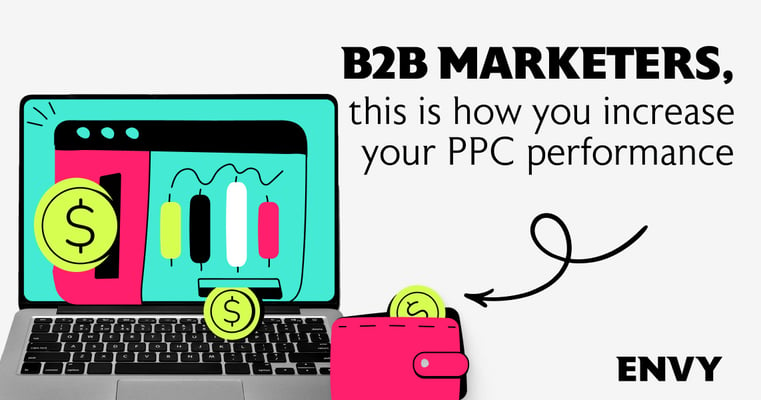
B2B PPC performance optimizations you can’t skip
Here’s one thing with marketing–you’re never ever really done. You completed one task, three others popped up. You’ve generated 100 opportunities, management now wants 200 more. You’ve released your paid campaigns, and now you have to optimize it. And again. And again. It’s a never ending cycle (but we’re all dopamine addicts, aren’t we) but there are a couple of things that can make your life easier, or at least optimizing your paid campaigns. Here they are.
No inbound? No PPC!
First thing’s first, well performing, lead-generating and revenue-driving B2B PPC campaigns are great, but they won’t be well performing, lead-generating and revenue-driving if they’re not based on good quality content in multiple formats. PPC campaigns do not equal a set of ads–they’re sooooo much more. More content, that is. In fact, it’s so important that that’s what might be keeping your paid campaigns away from generating high-quality leads and driving significant revenue growth in the first place.
Just think about it. Someone clicks on your ad to be sent to a landing page that… doesn’t say anything relevant to them or the problems you offer a solution to in your ad. What do you think they do? Hell yeah, they bounce. With no hesitation. In addition, Google will also penalize you with a low quality score (more on that below).
Or worse, someone clicks on your ad, reaches your website and does not find additional content of interest to keep them around. You don’t have content to nurture them. You’ve wasted money on bringing them in in the first place. So think content – blogs, videos, ebooks, useful web pages, podcasts, webinar recordings, whatever. You don’t need to invest in all formats. You do need to pick your formats and invest for the long term, not a one off.
The chances of you converting a complete stranger with a single creative (or piece of content) are pretty much comparable to Envy beginning their blogs with “in the ever-evolving marketing landscape”. We don’t like it, and search engines don’t like AI-generated content either. It’s just not gonna happen. So if you wanna convert them, offer valuable content, nurture the relationship with tips and tricks they didn’t even know they needed.
Before launching any paid campaign, make sure you’ve thought through every stage of the funnel and planned your campaign with the full funnel in mind, so it’ll feel as seamless as possible for your leads to move further and further down the process.
Here’s how you optimize your B2B PPC performance
Time to get straight to business now. We’re talking keywords, settings and targeting.
Removing Low-Performing Keywords from and Adding Negative Keywords to Google ads
In short, low-performing keywords are out, negative keywords are in.
Low-performing keywords are these terms that aren't generating clicks or conversions and are ultimately wasting your ad spend. Regularly review your campaign data to identify these underperforming keywords and eliminate them from your targeting list, at least until you’re able to improve their performance.
The best indicator in this case will be the quality score–and we’d generally advise pausing anything with a score below 5. You don’t want to waste your budget. Google will tell you why they rated your ads low–for example you’re aiming to target keywords that are too broad (let’s say “cybersecurity” when you could be saying “cybersecurity company new york”) or when your ads aren’t strongly related to your landing page (maybe you’re not using the keywords often enough in your landing page?)
On the other hand, consider adding negative keywords to your campaigns. Negative keywords are terms that you don't want your ads to appear for, helping you avoid irrelevant traffic and improve the overall quality of your leads. For example, if you're selling enterprise software, you might add "free" as a negative keyword to avoid attracting users looking for free solutions.
Utilizing Ad Extensions for Enhanced Visibility
Ad extensions are a valuable and FREE tool for enhancing the visibility and effectiveness of your PPC ads. These additional pieces of information can provide users with more context about your business and encourage them to click on your ads for FREE. So if you’re running Google Ads, you might want to squeeze as much out of it as possible, right?
There are several types of ad extensions available, including site link extensions, callout extensions, and structured snippets. You might want to experiment with different extensions to see which ones resonate most with your audience and drive the best results. And of course, the more relevant information you can provide, the better your chances of capturing user interest.
Here’s an example of sitelink extensions from Quantum Machines, with the general idea behind them being to save users a click or two and help them land on the page they’re looking for quicker. This screams high intent, doesn’t it?
Exploring Manual Bidding for Better Control
Automated bidding can be a convenient option, but it doesn't always provide the level of control you need when you’re aiming to maximize ROI. Manual bidding allows you to set specific bids for each keyword, giving you greater control over your ad spend and the ability to prioritize high-performing terms.
Needless to say, it means monitoring your campaigns closely and adjusting bids as needed–increasing bids for keywords that are driving conversions and decreasing bids for those that aren't performing well (at least until you manage to optimize copy for them to convert better, but we’ll get to that in a moment). By taking a hands-on approach to bidding, you can ensure your marketing dollars don’t go to waste.
The Importance of Conversion Tracking
If the ultimate goal of your PPC campaign is to drive conversions, then we need to track… well, conversions. Without it, you won't have a clear understanding of how your campaigns are performing and which keywords are driving the most valuable actions. Set up conversion tracking on platforms you’re currently advertising on to monitor key metrics such as form submissions, downloads, and purchases.
.gif?width=1920&height=850&name=download%20(1).gif)
Knowing When to Keep Optimizing vs. When to Scrap It
Not every lead gen campaign on LinkedIn will be a home run, and that's okay. The key is knowing when to keep optimizing and when to cut your losses and move on. If a campaign isn't delivering the desired results despite your best efforts, it may be time to scrap it and try a different approach. This can be especially tricky to determine for B2B folks, when the sales cycle is usually longer (think months). Even though a campaign is generating lovely leads in the first days or weeks, it’ll take time to determine if they’re materializing into MQLs/SQLs–and that’s exactly why you can’t scrap or praise your campaign too quickly.
Before you even launch, see if you have enough budget for your B2B PPC campaign to last long enough for you to be able to determine its success (or lack thereof). As a rule of thumb, we usually recommend keeping the campaign live for a minimum of 3 months to be able to learn from the successes or failures.
When deciding whether to continue optimizing or scrap a campaign (given your minimum agreed time has passed), consider factors such as cost-per-click (CPC), conversion rate, and overall ROI. If these metrics are consistently underperforming, it may be more beneficial to reallocate your budget to a different strategy. Remember, flexibility and adaptability are essential in the world of PPC.
Optimizing Ad Copy for Maximum Impact
The internet is drowning in ads. Worse, people get bombarded with irrelevant ads they’ll forget about in a matter of seconds. How do you make them stop from mindless scrolling? Or remember your brand? That’s exactly how your ad copy plays a crucial role in the success of your PPC campaigns. Compelling, relevant, and engaging ad copy can significantly increase click-through rates (CTR) and drive more conversions. Focus on creating headlines and descriptions that speak directly to your target audience and highlight the unique benefits of your product or service. To be able to do that, you need to know who your audience is and understand their pain points–that’s how you build a B2B PPC campaign that works.
For example, this is how the “Contact Request’ looked like for one of our clients Nuvei (who, by the way, managed to grow the number of leads by 54% within a year?!) before and after some (small changes). See the people in the background?
| Before | After |
This is another bit from their old page… which is looong 🥱 So we shortened it a bit to make it clearer.
| Before | After |
And when the previous version was very detailed… We tried to get straight to the point and use the real estate we gained for more CTAs to make it easier for people to convert.
| Before | After |
And what do the numbers say? The change helped double the conversion rate and lower the CPL by 60% at the same time. Crazy what a difference these changes can bring, ha?
So A/B everything. Always A/B. A/B testing different versions of your ad copy can help you determine which messaging resonates most with your audience. Experiment with various calls-to-action (CTAs), value propositions, and formats to find the winning combination. But please don’t A/B test for the sake of A/B testing alone… that’s just wasted resources.
Source: dataiku
Remarketing to Re-engage Prospects
Not remarketing is like not recycling your content. We’ll never understand why????
Nowadays people need more and more touch points before they even interact with your company. Considering the number of ads we need to digest on a daily basis, no wonder. So why would you expect anyone to remember, not to mention engage with your brand after seeing one random ad? Or reading one of your blogs? No one will. You wouldn’t!
But since we have insights into who viewed your website, even down to a specific page and how much time they spent there, why not use it? Create custom audiences based on that behavior, craft personalized ads and show your company again, and again, and again until the name sticks in their brain, so that the next time they think about a cybersecurity company, they see your ads in front of their eyes.
And of course, you’ll want to review your PPC performance on a regular basis to see what needs optimizing before you waste your marketing dollars.
Looking to take your PPC efforts to the next level? Consider hiring an experienced PPC agency. With their (our) expertise and resources, they (we) can help you maximize your ROI and achieve your marketing goals 😉 Reach out today to learn how they can support your business's growth.







.png?width=352&name=Nuvei%20blog%20cover%20(1).png)